The mood was already tense in Detroit’s expansive ballot-counting hall when President Trump tweeted on Nov. 4 that “a terrible thing” was “happening” in Michigan.
It was the third day of processing ballots, and that morning Chris Thomas had heard a weird rumor traveling around the counting floor.
A fellow election worker told Thomas, who was advising Detroit on its election after serving for 36 years as the state’s election director, that calls were welling on social media and email listservs urging local Republican “volunteers” to come down to the TCF Center, the massive conference hall where Thomas and his colleagues were hard at work.
“Come down here and do what?” Thomas thought to himself.
It didn’t take long for him to find out.
As the President tweeted false accusations of ballots being “found” for Democrats, an influx of fresh poll challengers — many of them Republican or affiliated with a conservative “election integrity” group — arrived at the TCF Center.
The number of people inside the hall swelled until the large counting room, originally designed to host the North American International Auto Show, was at capacity. Several of the new arrivals congregated in the lobby outside of the hall, alongside experienced poll watchers of both parties who had left for lunch. At this point, the building’s management was refusing to let anyone else inside.
The newcomers who had made it onto the counting floor became increasingly aggressive, haranguing ballot counters. A handful of people in the room started a chant: “Stop. The. Count.” It failed to catch on at first, but it quickly spread to the several dozen wannabe observers stuck in the lobby looking in. Soon, the lobby crowd — mostly white — was banging on the windows to punctuate the chants as election workers — mostly Black — looked on from inside the hall, mere feet away.
“I think they all felt that this is definitely something different, something aggressive,” Thomas said of his colleagues.
The night before, in nationally televised remarks from the White House, Trump claimed he had won the election, and any results still coming in showing otherwise were “major fraud” to steal his victory from him. Trump demanded that “voting” — i.e. the continued counting of mail-in ballots — be “stopped.”
Trump continued the claims through Wednesday morning, and in a tweet singled out Michigan in particular. Moments later, his campaign announced a lawsuit seeking to stop the state’s count.
But the Trump supporters gathered at the TCF Center weren’t going to wait for the judicial system. They would take matters into their own hands.
As the “stop the count” chant continued, building management placed cardboard over some of the windows, quickly attracting scorn from GOP officials on social media. Police eventually arrived, lining up between the crowd and the windows. It took several more hours before the Republican activists fully dissipated.
“It unnerved a lot of people, particularly in the room,” Thomas recalled.
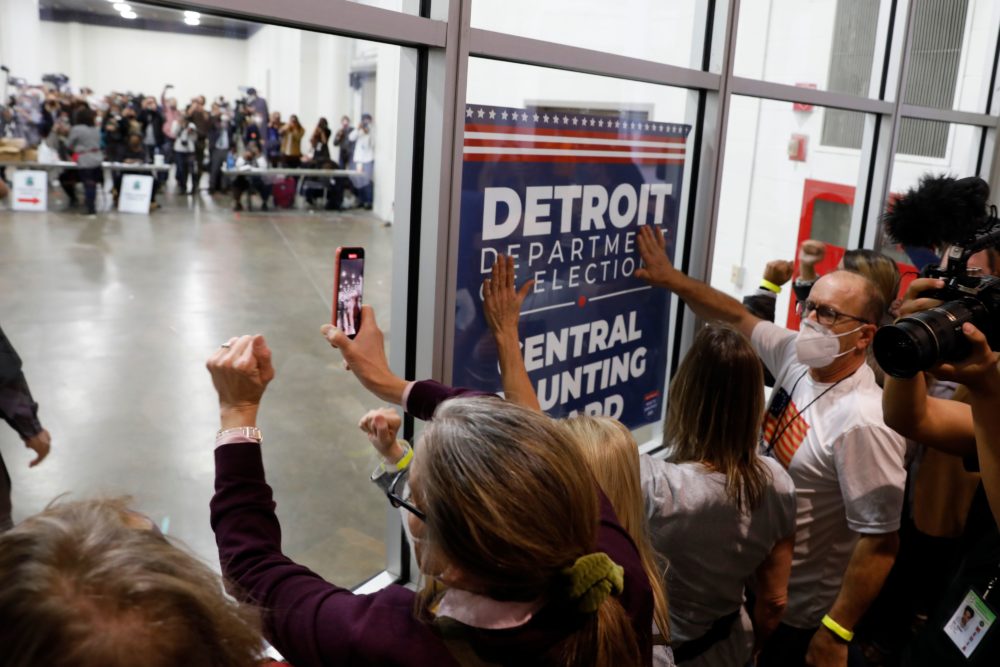
The scene at the TCF Center, though unsettling for the election workers inside counting the ballots, never escalated to the outright violence and damage that later befell the U.S Capitol on Jan. 6.
But it foreshadowed what was to come.
That day in January was preceded by a series of increasingly destructive schemes launched by President Trump and his allies aiming to reverse Joe Biden’s win. Some occured out in the open and were documented in real time, like the events at the TCF Center. Others took place behind closed doors, like the crisis at the Justice Department that came to a head two months later, when the President weighed whether to replace his acting attorney general with a Justice Department official more willing to try to overturn the election.
But the conspiracy started many months before, when Trump convinced his followers that only fraud could explain any election that didn’t result in his victory. As it became clear that he had lost, and not even that narrowly, Trump used that lie to propel a previously unthinkable attack on democracy. With the help of close aides, faraway operatives and admirers who needed to look no further than the President’s Twitter feed to understand what he wanted them to do, Trump tested every vulnerability in the democratic process — every weak point in the electoral system where, perhaps, someone could be convinced or bullied to ignore the will of the people.
Trump’s cadres, often at his direct instruction, brought forth frivolous lawsuits, harassed election workers, and twisted the arms of state officials behind the scenes.
As the window for undoing Biden’s victory closed ever more tightly, Trump’s claims about election fraud became more convoluted, his boasts of how he actually won more sweeping, and his plotting more desperate. In the end, he was reduced to riling up a deranged mob to set upon the Capitol.
Always present, however, was the false insistence — often deployed as a racist appeal — that the election, supposedly plagued by fraud, had been “rigged” against the President.
Trump and his co-conspirators never put forward any real evidence of such impropriety. And there was never really a plausible scenario in which Trump was going to be able to overturn his defeat legally. But in the absence of any legitimate path to victory, the short-term goal of this multi-stage plot was always the same: disrupt the counting, disrupt the canvassing, disrupt the certification — all the way to the pinnacle declaration of Biden’s win, Congress’ ratification of the Electoral College vote earlier this month.
“The mob was fed lies,” then-Majority Leader Mitch McConnell (R) said on the Senate floor on Tuesday, not mentioning that at least in the first few weeks after the election, he himself had avoided pushing back directly on the President’s false claims.
“They were provoked by the President and other powerful people,” McConnell said. “They tried to use fear and violence to stop a specific proceeding in the first branch of the federal government, which they did not like.”
‘There Won’t Be A Transfer’
Perhaps it shouldn’t be a surprise that the normally ceremonial tradition of Congress formalizing a presidential victory was besieged with brute chaos egged on by Trump. The President never said he was committed to a peaceful transfer of power.
Back in September, just as early voting was about to get started, a reporter asked him point-blank at a White House press conference to make such a commitment.
“We’ll see what happens,” Trump groused, while batting away the reporter’s efforts to press him on the question.
“Get rid of the ballots and you’ll have a very peaceful —” the President said, before stopping himself. “There won’t be a transfer, frankly, there’ll be a continuation.”
At the time, Trump’s defenders played down the remarks, and claimed that he was just pushing back on the supposedly unfair, pandemic-related changes to the election system. But looking back, Trump’s coyness was a preview — and a warning.
The President had been on an unrelenting disinformation crusade to convince his supporters that voting by mail was a “scam” and that any election buoyed by mail-in voting — an inevitability in 2020, with the complications the COVID-19 outbreak posed to in-person voting — would be rigged against him.
His rhetoric was accompanied by a Republican legal strategy seeking to make absentee voting harder; a PR push — by the GOP’s both official and unofficial apparatus — to buttress Trump’s false claims; and even tinkering at the U.S. Postal Service by a Trump-aligned postmaster general that threatened to hamstring mail-in voting.
Those maneuvers were effective at polarizing the use of vote by mail and, in key battleground states, turning Republicans away from the practice. Come the night of Nov. 3, a widely predicted forecast became reality. The in-person vote made up the bulk of the completed count in certain battleground states at the end of Election Day, showing Trump with an apparent lead. But as those states processed absentee ballots, that edge disappeared, tilting the count toward Biden.
Thus kicked into gear the next phase of Trump’s bid to stave off his defeat: disrupting the counting of votes that would foreclose his re-election.
‘We Don’t Want Them To Find Any Ballots’
A tightly packed, mostly mask-free group of supporters awaited Trump when he entered the White House East Room at around 2:20 a.m. the morning after Election Day. Trump had promised on Twitter that he’d be giving a “statement” on the “big WIN” of that night. Several swing states were nowhere close to being called, and even though Trump had put a few important states in his column, he was well short of the 270 Electoral College votes needed to win.
Most of Trump’s children, as well as their partners, were eagerly seated in the front row of the East Room. Vice President Mike Pence and his wife, Karen, joined the President at his side, as did First Lady Melania Trump. Among the 150 or so top aides who had gathered for the remarks was White House Chief of Staff Mark Meadows, who, according to The Washington Post, mingled in a crowd that included top donors and campaign veterans like Corey Lewandowsi, Trump’s first 2016 campaign manager.
“We were getting ready for a big celebration,” Trump told the crowd and the television audience watching him from their homes. “We were winning everything and all of a sudden it was just called off. The results tonight have been phenomenal.”
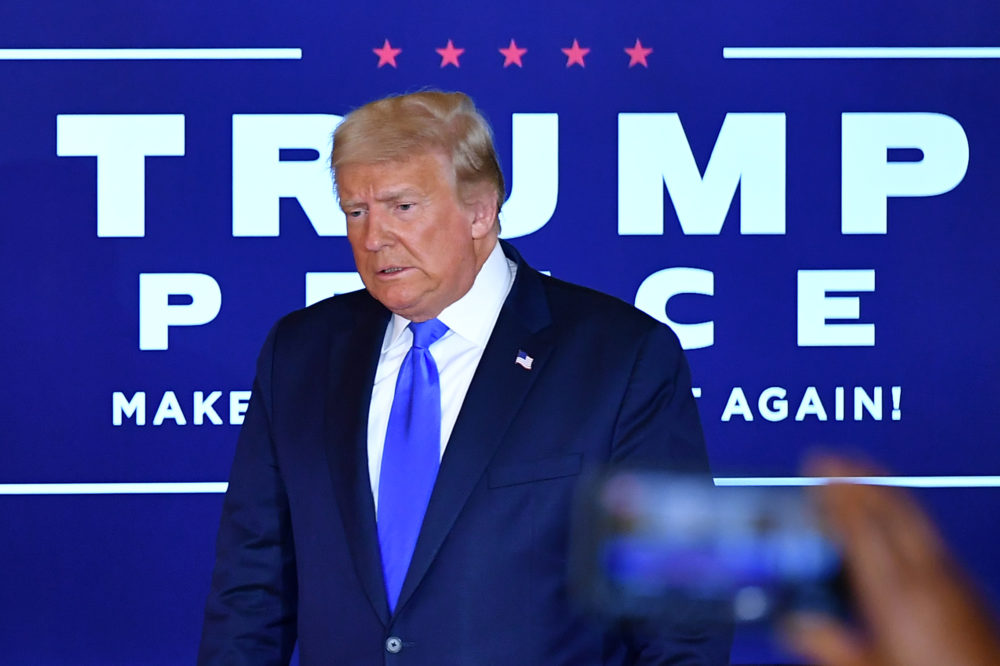
In the hours before Trump took the stage to give the pseudo-victory speech, he had actually been in a panic. Fox News’ declaration just before midnight that Biden had won Arizona had sent the President and his advisors into a tailspin, Axios recently reported. The call had spoiled the momentum the President had hoped to have when the vast majority of mail ballots in states like Pennsylvania and Wisconsin were still to be counted. But Trump stuck with the plan that, according to Axios, he had been rehearsing since mid-October. He prematurely declared himself the winner. He insisted that any ballots that remained to be counted were part of a scheme to steal the election for Biden.
“This is a fraud on the American public,” Trump told his supporters during that early morning speech. “This is an embarrassment to our country. We were getting ready to win this election. Frankly, we did win this election. We did win this election.”
He promised a trip to the Supreme Court to stop more votes for Biden from trickling in.
“We want all voting to stop,” he said. “We don’t want them to find any ballots at four o’clock in the morning and add them to the list. Okay?”
The next few days felt like a fever dream. In private, the White House was railing at Fox News for declaring Arizona for Biden and trying to convince other outlets that the network had gotten it wrong. Publicly, Trump’s associates engaged in increasingly clownish antics to stop the literal counting of ballots in states that would put Biden over the top.
The first stop for this hastily assembled operation was Pennsylvania, where ballot counting was expected to drag on for several more days.
Speaking to a scrum of reporters at a private jet terminal at Philadelphia International Airport on Nov. 4, Rudy Giuliani argued that 125,000 ballots should simply be “deducted from the count” in Pennsylvania because Republican observers supposedly didn’t get to watch them be counted. A campaign lawyer later admitted to a federal judge that Trump’s team did, in fact, have “a nonzero number of people in the room” during ballot processing.
The following day, from the White House’s press briefing room, Trump asserted that “if you count the legal votes, I easily win.” He noted approvingly the “tremendous” amount of litigation brewing over the election results, which he said he’d predicted, given how unfair everything had been.
Hours later a group of campaign surrogates, led by former Acting Director of National Intelligence Ric Grenell, American Conservative Union Chair Matt Schlapp and former Nevada Attorney General Adam Laxalt, showed up in Las Vegas to announce a lawsuit seeking to stop the counting of votes in the state. They wanted to be in front of the TV cameras but had no interest in answering questions. After delivering remarks, they scurried toward their van to avoid responding to reporters.
“All of your questions about the details are legitimate questions,” Grenell said, but “they should be asked of Clark County.”
‘Stop The Count’
The long-shot lawsuits filed by the campaign and its allies aired overhyped complaints about the supposed lack of poll watcher access. Those unsubstantial allegations, in turn, fueled baseless claims on the right that election officials had something to hide — that there was a mass conspiracy to steal the election for Biden.
“Joe Biden should not wrongfully claim the office of the President. I could make that claim also. Legal proceedings are just now beginning!” Trump vowed on Twitter on Nov. 6.
Trump’s supporters took their cue.
Not just in Detroit, but in Philadelphia, Las Vegas and Phoenix, protesters showed up at local counting board locations yelling “Stop the count!” and alleging that the workers inside were scheming to steal the election for Biden. In Wisconsin, Trump-petitioned recounts of two counties, where many of the state’s Black voters lived, were slowed down by relentless ballot challenges by Trump supporters who had shown up to observe.
Aggressive operations to solicit allegations of supposed fraud popped up in key states. Republicans had a war room in Detroit’s TCF Center — two floors up from the ballot-counting operations — where they collected affidavits from the GOP challengers. Another Trump-aligned group, spearheaded by campaign and White House alumni, sought voters who would claim irregularities in Philadelphia. The White House liaison to the Justice Department was eventually banned from the DOJ building after she was accused of trying to ferret out information about department election investigations.
The witnesses these ad hoc operations found were trotted before cameras at Trump-sanctioned press events to push the stolen-election narrative.
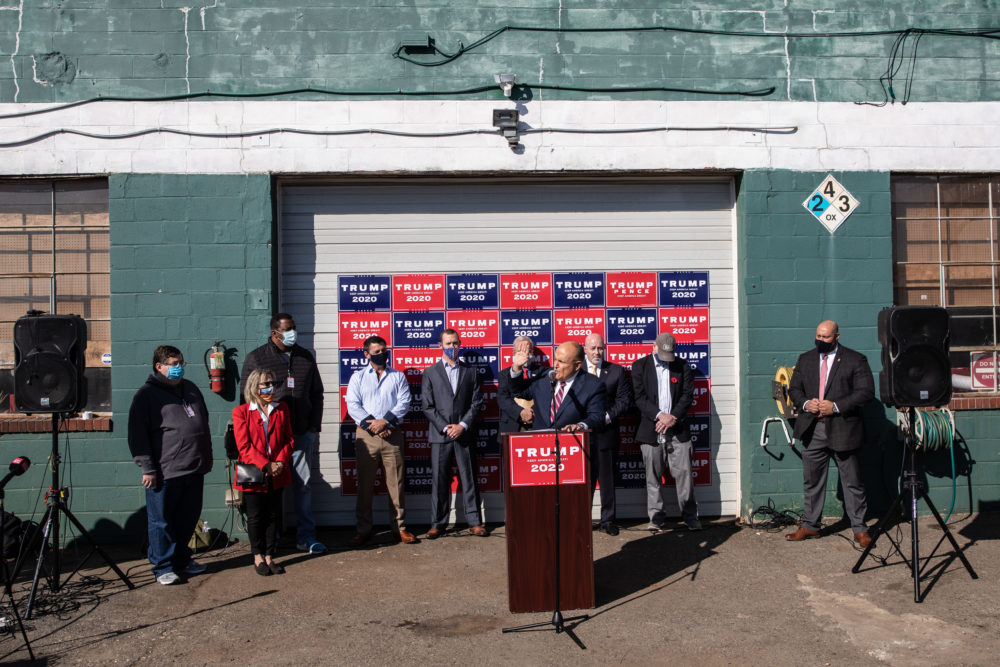
One of those witnesses, Lisette Tarragano, told TPM she was recruited by an associate of Corey Lewandowski after she recounted to local media her experience attempting to observe the vote count. Due to a credentialing dispute, Tarragano had never made it through the door of the Pennsylvania Convention Center to watch the counting of mail-in ballots.
She had no idea that, two days later, she would speak at one of the most memorable episodes of the Trump campaign’s attempts to meddle with the election results: the press briefing at Four Seasons Total Landscaping.
“The location changed several times that morning” before landing at the landscaping business, Tarragano said. “It was changed at least three times.”
Initially, she recalled, the event was set for the Union League of Philadelphia, then somewhere else near the airport. On Twitter, Trump hyped a press conference “at Four Seasons,” implying the luxury hotel, only to correct himself a few minutes later, presumably after a difficult phone call with his legal team. The hotel itself tweeted out a clarification that it would not be the site of the event.
Eventually, Giuliani, Tarragano, other witnesses and an audience of press made it to the landscaping business, down the street from Fantasy Island Adult Books and Viewing Booths.
As “Sweet Child of Mine” blared in the background — and just a few minutes before the major television networks called the race for Biden, catching Giuliani off-guard — Tarragano regaled the media in attendance with the story of her inability to enter the vote processing facility to observe the count.
Tarragano didn’t know she’d be asked to speak at the event. (“He just said, ‘Talk,’” she recalled of Giuliani.) And she had no idea how many press would be there. “We weren’t told about what was going to happen,” she said.
Nonetheless, shortly after Tarragano left the podium, Giuliani surfed her wake to allege that 600,000 ballots had been cast and counted without proper observation in Pennsylvania, and that “a certain number” of that sum should simply be ignored — laying out a legal strategy that the campaign would try out in several states.
As their efforts to stop the literal counting of ballots faltered, MAGA world focused its argument on throwing out those ballots instead.
The amateurish yet bombastic nature of the public appearances to tout the legal strategy matched the quality of the lawsuits themselves. The campaign filed a lawsuit in Arizona, for instance, that piggybacked on the bogus “SharpieGate” theory, which had gone viral on social media, to allege that Trump voters’ ballots weren’t being read properly by tabulator machines. A lawsuit filed in Pennsylvania alleged that 700,000 ballots were illegitimate, only for that underlying claim to be removed, and then added back in.
Giuliani argued on behalf of the Trump campaign in that lawsuit, his first appearance in court in more than a decade. While he breathlessly told the court that the case was about “widespread nationwide voter fraud,” Giuliani also admitted to not knowing the meaning of basic legal terms like “strict scrutiny.”
As December approached, it was becoming clearer that the strategy of getting courts to toss ballots was going nowhere — a Nov. 27 appellate court decision was a particularly firm nail in the coffin of the Trump campaign’s legal operation. Even the most hard-charging established lawyers, who had been known for pushing fraud claims in the past, began backing away from the Trump judicial effort. Of the several dozen Trump-aligned lawsuits, only one case — which challenged a Pennsylvania county’s extension of the deadline for curing ballots — had brought any kind of victory and it only affected a handful of votes.
Outside the courtroom, however, Trump urged on the public demonstrations to support for his doomed cause, which were growing fiercer.
When supporters of his, including the right-wing gang the Proud Boys, flooded Washington, D.C., in mid-November for a “Million MAGA March,” the White House social media director tweeted photos of the surging crowd. “We will WIN!” Trump tweeted above one crowd shot. “Hundreds of thousands of people showing their support in D.C.,” he added later. “They will not stand for a Rigged and Corrupt Election!”
As the rally peaked, Trump drove past in his motorcade, sending the crowd into a frenzy. That night, after videos trickled out online of chaotic street fighting in D.C. between Proud Boys, anti-fascists and others, the President celebrated his troops: “ANTIFA SCUM ran for the hills today when they tried attacking the people at the Trump Rally, because those people aggressively fought back,” he tweeted.
For all the steam gaining in rallies outside the White House walls, the President’s legal operation was shrinking to a few of his most devoted but unhinged supporters. Giuliani was joined on the team by two new faces: Sidney Powell and Jenna Ellis. Powell’s client, Michael Flynn, was looking for a pardon from the President, and had become a hero to the Trump-worshipping QAnon movement.
Powell and Ellis brought with them a change in strategy. Because the effort to toss out Democratic ballots in court wasn’t working, they’d focus instead on delaying the procedures that would formalize Biden’s win.
‘We Have To Turn The Election Over’
The Trump team introduced this new approach on Nov. 20, to an astonished press corps at the Republican Party’s stately national headquarters. As Giuliani rattled on, he gifted the world the indelible image of what appeared to be hair dye dripping mercilessly past his temples.
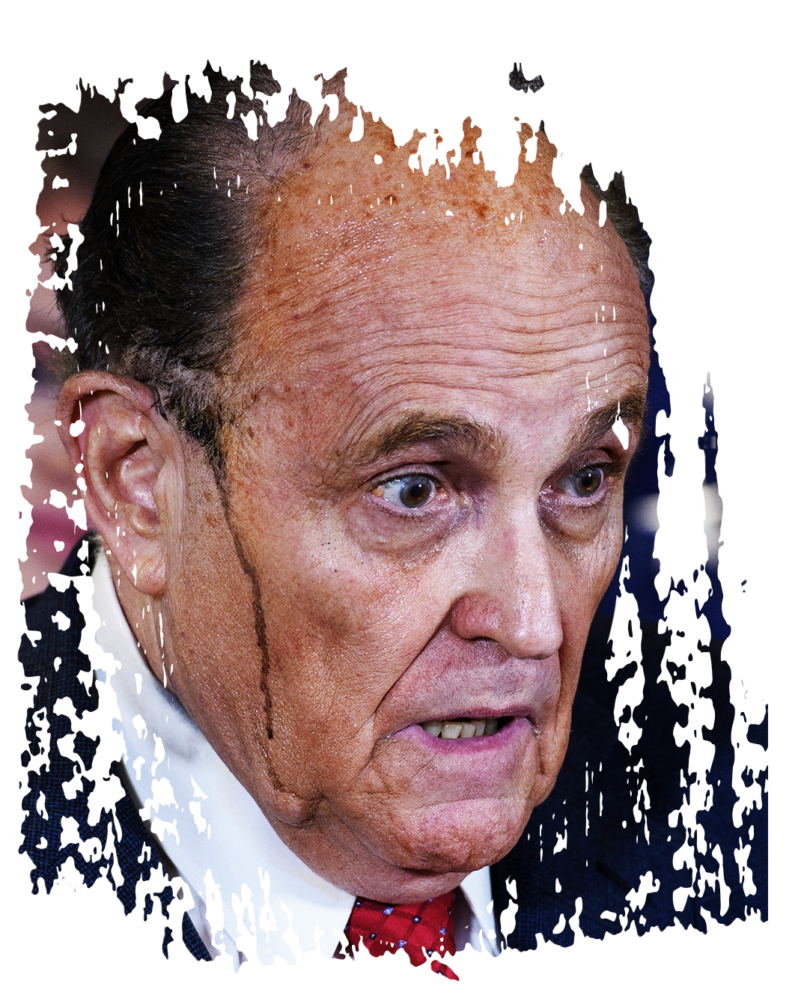
But perhaps more noteworthy than this image, in hindsight, was how the press event marked a shift away from narrow, whack-a-mole legal complaints to one grand, outlandish conspiracy theory that posited no less than a global communist sleeper cell plot to subvert American democracy.
No longer was the goal to convince a court why a particular set or subset of ballots were suspect. The entire election, across several states, was so tarred with fraud, in Giuliani and his associates’ telling, that it required the drastic action of Republican legislatures rejecting Biden’s win altogether. The legislators, they hoped, would swap in a Trump slate of electors instead.
Opening the briefing, Giuliani said that his team had noticed a “pattern” of fraud across several states — one that pointed not to one-off cases of fraud, but rather to “a plan from a centralized place to execute these various acts of voter fraud.” But the claims took a more bizarre turn when Powell took the stage. Clad in leopard print and speaking in a North Carolina drawl, she started strong: The voting systems produced by Dominion and Smartmatic, she said, “were created in Venezuela at the direction of Hugo Chavez to make sure he never lost an election.”
“We have one very strong witness who has explained how it all works,” Powell assured viewers, as she described an insane fraud scheme, perpetrated by communists, in which machines “flipped” and “injected” votes while counting just a fraction of each ballot that Trump received.
“We are going to reclaim the United States of America for the people who vote for freedom,” Powell declared.
Trump celebrated the media coverage his attorneys received. “Lawyers now on @newsmax, @OANN & maybe @FoxNews,” he tweeted. “An open and shut case of voter fraud. Massive numbers!”
The GOP also promoted Powell’s fantastical claims from its official Twitter account. And while, later that week, her nonsensical allegations earned her temporary exile from Trump’s team, she wouldn’t be cast out for long.

The seemingly far-fetched scenario of GOP statehouses in states that Biden won putting forward rival Trump electors instead was now the explicit goal of the President’s and his inner circle.
To make their case directly to the lawmakers who would need to execute the scheme, Giuliani and Ellis embarked on a cross-country trip to host “hearings” with state lawmakers to lay out their allegations. The events tried to present themselves as having some imprimatur of official legislative procedure, though they were usually held in hotel ballrooms, and only sometimes did they have the endorsement of the Republican leaders in the respective statehouse.
“This Election was RIGGED, but we will WIN!” Trump promised on Twitter after one of the events.
The first stop on the national tour was at a Wyndham hotel in Gettysburg. Trump’s plans to attend the Nov. 25 hearing in person were scuttled by another campaign COVID-19 outbreak, so the President weighed in on the proceedings by phone instead.
Via Ellis’ cell phone, which the attorney put on speaker, Trump proclaimed that he had won in a landslide, but that corrupt elections officials and judges were depriving him of his rightful second term.
“We have to turn the election over, because there’s no doubt we have all the evidence, we have all the affidavits, we have everything,” the President seethed. “All we need is to have some judge listen to it properly.” At one point, the President was interrupted by the repetitive beep of call waiting.

On it went from there. Eventually, the gambit began irritating even some Republicans. In Michigan, one memorable witness, IT contractor Mellissa Carone, interrupted state Rep. Steven Johnson (R) so frequently that Giuliani shushed her.
“I’m just saying, the numbers are not off by 30,000 votes,” Johnson said, referring to Michigan’s election poll books.
“I know what I saw!” Carrone shot back. “And I signed something saying that if I’m wrong, I can go to prison. Did you?”
Within a week, the tour would wind down with a COVID diagnosis for Giuliani, landing him in the hospital and sending multiple state legislatures he had visited into quarantines.
As his lawyer barnstormed the country, Trump was hard at work behind the scenes, doing his utmost to convince state and local officials that they did not need to go along with Biden’s win. He even cast the national spotlight onto the anonymous bureaucrats who oversee the typically ministerial process of certifying local election results, in some cases putting them under unrelenting pressure to delay those steps. Some resisted, but others, at least at first, were eager to go along.
Republicans on Michigan’s Wayne County Canvassing Board threatened to certify the county election results only if the Detroit vote was excluded from the count. After an emotional three-hour period for public comments, they backed down, though one of the Republicans still received a phone call that evening from the President expressing his support.
As the President’s efforts to pressure state officials repeatedly fell flat, the popular movement behind the President was growing, and election workers faced unyielding harassment. Protesters showed up at the home of Michigan Secretary of State Jocelyn Benson while she was getting ready to watch a Christmas movie with her son. A temp worker hired to count ballots in Georgia went into hiding after a video promoted by Trump’s two oldest sons falsely suggested he had tampered with the results.
By early December, election officials were begging for the President and his allies in Congress to stop spreading false claims of a stolen election.
“Someone’s going to get hurt. Someone’s going to get shot. Someone’s going to get killed,” Gabe Sterling, a top official in the Georgia Secretary of State’s office, warned at a Dec. 5 press conference. Calling for a condemnation of the violence, Sterling pleaded: “This has got to stop.”
Trump responded to Sterling’s entreaty on Twitter.
“Rigged Election,” he said. “Show signatures and envelopes. Expose the massive voter fraud in Georgia. What is Secretary of State and Brian Kemp afraid of.They know what we’ll find!!!”
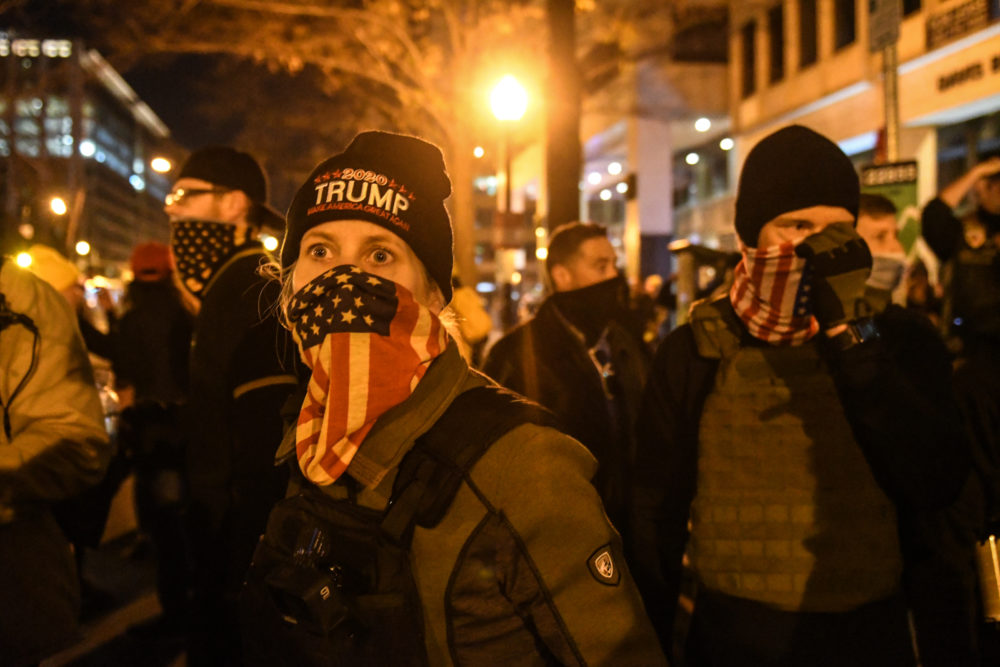
The following day, a rally for the “Stop the Steal” movement in Alpharetta, Georgia, brought Trump’s message home. Powell shared the stage with fringe lawyer Lin Wood. The day before the rally, Wood and Michael Flynn had endorsed a call for martial law in response to the election results. At least one person turned up in Alpharetta with an actual pitchfork.
Trump signaled his support for Wood’s approach, including by retweeting the lawyer a couple weeks later, when Wood wrote that Georgia’s Republican governor and secretary of state would “end up in jail” for defying the President’s efforts to overturn the election.
Trump also lent his endorsement to the second Stop the Steal rally in D.C., which took a more destructive turn. The President cheered on the Dec. 12 gathering in a tweet the morning it was to take place: “Wow! Thousands of people forming in Washington (D.C.) for Stop the Steal.”
By midday, he orchestrated a flyover in Marine One. On the rally stage below, the leader of the anti-government Oath Keepers pleaded for Trump to call up a citizen militia “now, while he is commander in chief.”
“We’re going to have to do it ourselves later, in a much more desperate, much more bloody war,” the Oath Keepers leader said.
That night, multiple people were stabbed and dozens arrested on the streets of D.C., and a pack of Proud Boys burned Black Lives Matter banners that had been ripped from two historically Black churches.
As the new year began, the ‘Stop the Steal” movement grew more vocal about using violence. Wood, the lawyer who had led the Georgia rally, predicted on Jan. 1 that Vice President Pence would face “execution by firing squad” for treason.
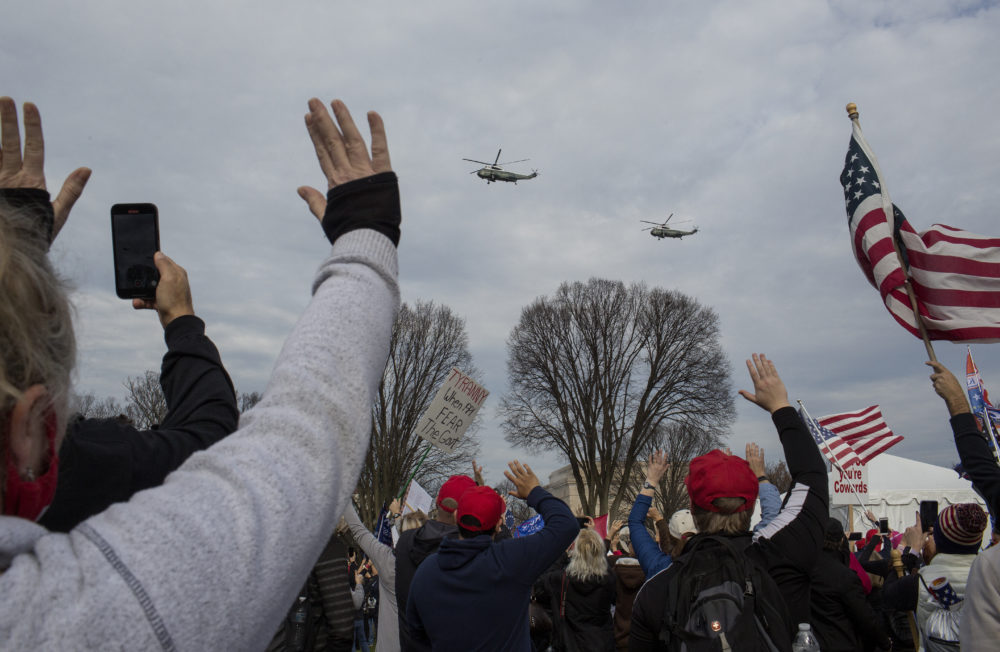
‘When The Right Answer Comes Out, You’ll Be Praised.’
By the time Georgia Secretary of State Brad Raffensperger finally got on the phone with Trump on Saturday, Jan. 2, the President had already called the Republican election official “a so-called Republican (RINO),” an “enemy of the people” and a “complete disaster.”
Raffensperger had managed to avoid speaking with the President for two months by that point. Soon after Biden overcame Trump’s lead in the Georgia count, word made it to Raffensperger’s aides that the Trump campaign wanted to speak with them. The secretary of state’s office, pointing to litigation related to the vote totals, danced around the requests for Trump to speak to Raffensperger, but the President only grew more persistent, with the White House switchboard making 18 calls to his office in the two-month period. The White House even resorted to using the publicly advertised office phone number for the media. When the low-level staffer who answered the calls took down the messages, the office assumed they were being pranked.
Unable to connect Trump with Raffensperger directly, emissaries for the President tried to grind him down on Trump’s behalf. Sen. Lindsay Graham (R-SC), in Raffensperger’s retelling of a Nov. 14 call, had floated the idea of Raffesperger tossing out a large chunk of the mail-in ballots. Two nights before Christmas, Trump had managed to get on the phone with the top investigator in Raffensperger’s office and had told the official to focus her scrutiny on Fulton County, which is home to Atlanta. “When the right answer comes out, you’ll be praised,” Trump told the official.
When on Jan. 2 Trump finally got ahold of Raffensperger directly, he gave him an earload.
Georgia’s election results were “off by hundreds of thousands of votes,” Trump claimed. He demanded that Raffensperger “find” 11,780 votes, the margin by which he had lost to Biden in the state. He said that “many criminal events” had happened in the election under Raffernsperger’s watch, and that Raffensperger himself could face criminal prosecution.
“It is more illegal for you than it is for them because, you know, what they did and you’re not reporting it,” Trump said. “That’s a criminal, that’s a criminal offense.”
The rambling, hour-long conversation — mostly dominated by Trump’s scattered thoughts — showed new depths of the President’s insane beliefs, about both the election and the scheme he was pursuing to overturn its results. The Trump advisors listening in on the call did their best to keep the President on track, but they too were pressing Raffensperger to come to a “compromise” — in chief of staff Mark Meadows’ words — that would boost their baseless fraud allegations. One lawyer who was on the Trump side of the call suggested that Raffensperger “deputize” the president’s legal team so they could look at certain voter data that had, so far, not been released to them due to state privacy laws.
When, the next day, Trump posted a disparaging tweet about how Raffensperger had supposedly handled their conversation, a recording of the call was leaked, in its entirety, to the Washington Post and other outlets.
Unbeknownst to the public, as the fallout from the Raffensperger call was making headlines, a separate Trump scheme to weaponize the Justice Department to attack Biden’s win was coming to a head. The leaders of the Justice Department, including Attorney General Bill Barr, who left in late December, had refused to endorse Trump’s fraud claims. But Trump eventually found an alleged collaborator in Jeffrey Clark, then the head of the DOJ Civil Division. Clark proposed actions the department could take to convince state lawmakers to throw out Georgia’s results, according to the New York Times.
The weekend that the news of the Raffensperger call broke, Clark reportedly informed Acting Attorney General Jeffrey Rosen, who had resisted the President’s entreaties, that the President was going to sideline him. Clark would step into the role of acting attorney general, according to the New York Times’ report on the scheme, where he would try to use the department to block Congress’ certification of Biden’s win.
Once the department’s other leaders learned of the plot, they made a pact to resign en masse if Trump executed the shake-up. The stir that would have been caused by such a pact — which evoked the memory of Nixon’s Saturday Night Massacre during Watergate — helped dissuade Trump from placing Clark in control.
But not everyone at the Justice Department escaped Trump’s scheming. The U.S. Attorney in Atlanta, Byung Jin “BJay” Pak, had earned Trump’s ire for refusing to launch frivolous investigations of voter fraud; Trump referred to him on the Raffensperger call as a “Never Trumper.” The day after the call, a top DOJ official told Pak to leave his post two and a half weeks earlier than he had planned. On Monday after that weekend, Trump intervened in the line of succession to install Bobby Christine, a U.S. Attorney in southern Georgia, as the head of the Atlanta office.
‘You’ll Never Take Your Country Back With Weakness’
Trump’s hopes for overturning the election in the states were foundering. So, as 2020 came to an end, Trump increasingly focused his attention on what his Republican allies in Congress could do to subvert the results.
Even if Trump was not ultimately able to commandeer the Justice Department for his election-reversal aims, he had plenty of loyalists in the House who had shown themselves eager to amplify his stolen election narrative. Roughly two-thirds of the House Republican caucus signed on to a brief supporting a Texas lawsuit before the U.S. Supreme Court lawsuit to overturn the election. In the Senate, potential 2024 presidential contenders sought to outflank one another in their willingness to prop up Trump’s fantasies about overturning the election.
Sen. Josh Hawley (R-MO) announced in late December that he would join a group of House Republicans in challenging the Electoral College vote when it was counted by Congress on Jan. 6. Days later, Sen. Ted Cruz (R-TX), backed by nearly a dozen other GOP senators, unveiled his plans for objecting to the vote, which included a demand that a “commission” be set up to investigate the results.
But the role that Vice President Pence was to play in presiding over Congress’ certification of the Electoral College vote became an obsession of the President’s. The vice president’s function during the ceremony is ministerial, yet Trump had convinced himself that his loyal deputy could unilaterally call off the counting and prevent Biden’s win from being formalized.
Trump confronted Pence repeatedly about his belief that Pence had the ability to subvert the process, including in multiple encounters on the day before the vote, the New York Times reported. The President tweeted the assertion as well.
The tension gripping the country increased as Jan. 6 drew near. In a Washington Post op-ed that seemed to anticipate a problem of which the public was not yet fully conscious, all 10 living former defense secretaries urged acting defense secretary Chris Miller not to involve the military in the transfer of power. Right-wing agitators, meanwhile, were making their way to D.C. for a third “Stop the Steal” rally. On social media, some Trump supporters described emotional farewells with family members before departing for D.C. — preparations for the potential that, as one poster wrote, “our ‘leaders’ do the wrong thing and we have to storm the Capitol.” Trump hyped the event repeatedly — and even announced that he would speak to the crowd.
“I hope the Democrats, and even more importantly, the weak and ineffective RINO section of the Republican Party, are looking at the thousands of people pouring into D.C. They won’t stand for a landslide election victory to be stolen,” Trump tweeted at 5:12 p.m. the evening of Jan. 5, tagging Senate Majority Leader Mitch McConnell (R-KY), Majority Whip John Thune (R-SD) and Sen. John Cornyn (R-TX), all of whom had come out against his Electoral College subversion gambit. A half-hour later, Trump gave his supporters 17 hours to get to Washington. “I will be speaking at the SAVE AMERICA RALLY tomorrow on the Ellipse at 11AM Eastern,” he tweeted. “Arrive early — doors open at 7AM Eastern. BIG CROWDS!”

That night, at a rally at Freedom Plaza, Michael Flynn told the crowd that Americans “bleed” for freedom, and that the soil on which they stood would be “fought for” in the future. He addressed members of Congress: “Those of you who are feeling weak tonight —- those of you that don’t have the moral fiber in your body, get some tonight. Because tomorrow, We the People are going to be here, and we want you to know that we will not stand for a lie.”
On the morning of Jan. 6, Trump was still badgering Pence. He put the choice before his vice president succinctly, according to the New York Times: “You can either go down in history as a patriot or you can go down in history as a pussy.”
Pence informed the President that he would not seek to block the certification himself.
Trump, reportedly, was enraged.
But where the voters, his lawyers, state legislators, elections officials, the DOJ and the vice president had all disappointed him, the masses that showed up in Washington to protest the Electoral College count would not. The mob brought the President pure glee.
The crowd was warmed up by several of Trump’s most loyal supporters, including members of Congress and two of the President’s sons. Donald Trump Jr., speaking in a characteristic shout, said the protest “should be a message to all the Republicans who have not been willing to actually fight, the people who did nothing to stop the steal.”
Giuliani, who assured the crowd that it was “perfectly legal” to throw out states’ votes, was more frank. “Let’s have trial by combat!” he yelled.
When it was Trump’s turn, speaking from behind a glass screen, he told his supporters that “our country will be destroyed” if Biden is allowed to take office “and we’re not going to stand for that.”
He accused Republicans of fighting like “a boxer with his hands tied behind his back” and of being too “respectful.”
“We’re going to have to fight much harder,” he said, warning that it was going to be a “sad day for our country” if Pence didn’t “come through for us.”
Trump told the crowd he was going to march with them down Pennsylvania Avenue toward the Capitol to “cheer on our brave senators and congressmen and women.” He ultimately never left the White House grounds.
“Because you’ll never take back our country with weakness. You have to show strength and you have to be strong. We have come to demand that Congress do the right thing,” he said, later adding that if his supporters “don’t fight like hell, you’re not going to have a country anymore.”
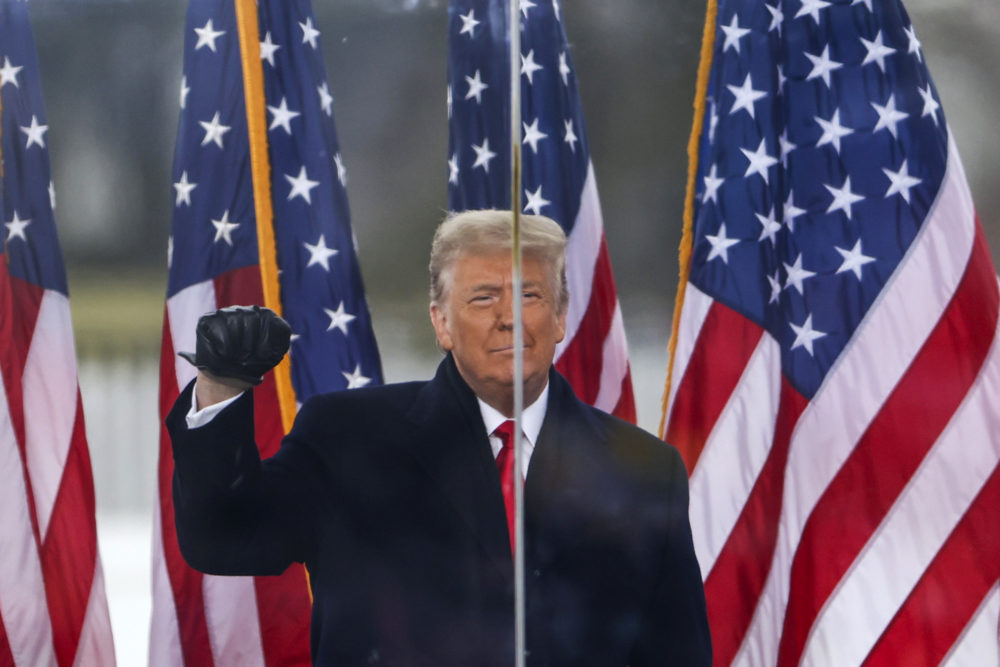
Trump’s remarks included a line instructing his supporters to “peacefully and patriotically” march to the Capitol. But that was not the message heard by the protest, which turned into a riot once it reached the Capitol lawn.
The crowd laid siege on the security perimeter, breaching its barricades and beating cops who stood in their way. They smashed windows and tore down doors to enter Congress’ hall. They rushed through the hallways and stormed the chambers of both houses mere minutes after the lawmakers were evacuated. They vandalized offices, took selfies with statutes.
“Murder the media” was scratched on one of the doors.

Trump continued to egg them on via Twitter, telling them that Pence had betrayed them by not disrupting the count. By the time he sent the tweet, rioters had already broken into the Capitol.
One Capitol Police officer was killed in the riot, and a Trump supporter was fatally shot as she was crawling through a window that separated the crowd from lawmakers by just several feet. Another woman was trampled to death by fellow rioters as they surged against a police line, just feet from where Joe Biden would eventually swear the oath of office. Two more participants died of health complications during the riot.
Some of the rioters could be heard on live streams justifying their actions with the President’s words.
“Our president wants us here,” one of the rioters in the Capitol said. “We wait and take orders from our president.”
Another rioter, facing the officers blocking their path into the building, yelled at them, “We were invited here by the President of the United States!”
One Kentucky man would later tell federal agents that he and his wife marched on the Capitol “because Trump said to do so.”
While the violence escalated, Trump balked at telling his supporters to stand down. His initial tweets addressing the mob urged them to stay “peaceful,” but stopped well short of directing them to retreat from the Capitol. Trump never called Pence that day to check in on him and his family. The President was reportedly transfixed by the television coverage of the riot.
It took several hours for insurrectionists to be cleared of the Capitol and for its spaces to be secured. In the days afterward, it would emerge that five people had died. When Trump did finally ask them to leave, he addressed the rioters with sympathy and in a tone usually reserved for young children.
“We love you. You’re very special. Go home,” the President intoned. “I know your pain. I know you’re hurt.”
“We had an election that was stolen from us. It was a landslide election,” he said, “and everyone knows it.”
Correction: An earlier version of story included quotes reported by Washington Post from Trump’s call with a Georgia election investigator that the Post has since clarified were inaccurate. This story has been updated to include quotes from a recording of the call, which was made public by the Wall Street Journal.

